Lung cancer CT: Difference between revisions
No edit summary |
|||
| Line 28: | Line 28: | ||
{| align="left" | {| align="left" | ||
|- valign="top" | |- valign="top" | ||
| [[Image:IJRI-25-109-g001.jpg|thumb|350px|Common radiological appearances of lung cancer. Centrally located mass with mediastinal invasion (arrow, A), peripherally situated mass abutting the pleura (arrow, B), mass with smooth, lobulated margins (arrow, C) and with spiculated, irregular margins (arrow, D), via <https://www.ncbi.nlm.nih.gov/pmc/articles/PMC4419420/figure/F1/>This is an open-access article distributed under the terms of the Creative Commons Attribution-Noncommercial-Share Alike 3.0 Unported, which permits unrestricted use, distribution, and reproduction in any medium, provided the original work is properly cited.<ref name="PurandareRangarajan2015">{{cite journal|last1=Purandare|first1=NilenduC|last2=Rangarajan|first2=Venkatesh|title=Imaging of lung cancer: Implications on staging and management|journal=Indian Journal of Radiology and Imaging|volume=25|issue=2|year=2015|pages=109|issn=0971-3026|doi=10.4103/0971-3026.155831}}</ref> | | [[Image:IJRI-25-109-g001.jpg|thumb|350px|Common radiological appearances of lung cancer. Centrally located mass with mediastinal invasion (arrow, A), peripherally situated mass abutting the pleura (arrow, B), mass with smooth, lobulated margins (arrow, C) and with spiculated, irregular margins (arrow, D), via <https://www.ncbi.nlm.nih.gov/pmc/articles/PMC4419420/figure/F1/>This is an open-access article distributed under the terms of the Creative Commons Attribution-Noncommercial-Share Alike 3.0 Unported, which permits unrestricted use, distribution, and reproduction in any medium, provided the original work is properly cited.<ref name="PurandareRangarajan2015">{{cite journal|last1=Purandare|first1=NilenduC|last2=Rangarajan|first2=Venkatesh|title=Imaging of lung cancer: Implications on staging and management|journal=Indian Journal of Radiology and Imaging|volume=25|issue=2|year=2015|pages=109|issn=0971-3026|doi=10.4103/0971-3026.155831}}</ref>]] | ||
]] | [[Image:IJRI-25-109-g002.jpg|thumb|350px|Lung cancers with atypical radiological pattern. Squamous cell cancer presenting as a cavitating mass (arrow, A). Adenocarcinoma presenting as dense consolidation (arrow, B). Bronchoalveolar carcinoma (adenocarcinoma in situ) presenting as ground-glass opacity (arrow, C) and mixed density, solid (arrow), and ground-glass nodules (arrowhead) in D via <https://www.ncbi.nlm.nih.gov/pmc/articles/PMC4419420/figure/F1/>This is an open-access article distributed under the terms of the Creative Commons Attribution-Noncommercial-Share Alike 3.0 Unported, which permits unrestricted use, distribution, and reproduction in any medium, provided the original work is properly cited.<ref name="PurandareRangarajan2015">{{cite journal|last1=Purandare|first1=NilenduC|last2=Rangarajan|first2=Venkatesh|title=Imaging of lung cancer: Implications on staging and management|journal=Indian Journal of Radiology and Imaging|volume=25|issue=2|year=2015|pages=109|issn=0971-3026|doi=10.4103/0971-3026.155831}}</ref>]] | ||
|} | |||
<br clear="left" /> | |||
|} | |} | ||
{| align="left" | {| align="left" | ||
Revision as of 16:29, 15 February 2018
|
Lung cancer Microchapters |
|
Diagnosis |
|---|
|
Treatment |
|
Case Studies |
|
Lung cancer CT On the Web |
|
American Roentgen Ray Society Images of Lung cancer CT |
Editor-In-Chief: C. Michael Gibson, M.S., M.D. [1] Associate Editor(s)-in-Chief: Saarah T. Alkhairy, M.D.; Kim-Son H. Nguyen, M.D., M.P.A., Cafer Zorkun, M.D., Ph.D. [2]
Overview
CT scans help stage the lung cancer. A CT scan of the abdomen and brain can help visualize the common sights of metastases: adrenal glands, liver, and brain. CT scans diagnose lung cancer by providing anatomical detail to locate the tumor, demonstrating proximity to nearby structures, and deciphering whether lymph nodes are enlarged in the mediastinum.
CT Scan
- Chest CT scan may be helpful in the diagnosis of lung cancer. Findings on CT scan suggestive of lung cancer include:[1]
- Solitary pulmonary nodule
- Centrally located masses
- Mediastinal invasion
- Peripherally situated lesions invading the chest wall
- A ground-glass opacity
- Consolidation
- Mixed density or pure ground glass nodules
- Mixed density or pure ground glass consolidation
- CT scans help stage the lung cancer. A CT scan of the abdomen and brain can help visualize the common sights of metastases: adrenal glands, liver, and brain.
- The benefits of CT Scans in lung cancer patients are the following:[2]
- Provides anatomical detail to locate the tumor
- Demonstrates proximity to nearby structures
- Deciphers whether lymph nodes are enlarged in the mediastinum
Unfortunately, research has shown that there are a number of false positives associated with CT scanning because a CT scan on its own cannot determine malignancy. A positive result for a tumor using a CT scan is typically followed up with a biopsy for confirmation. Images courtesy of RadsWiki
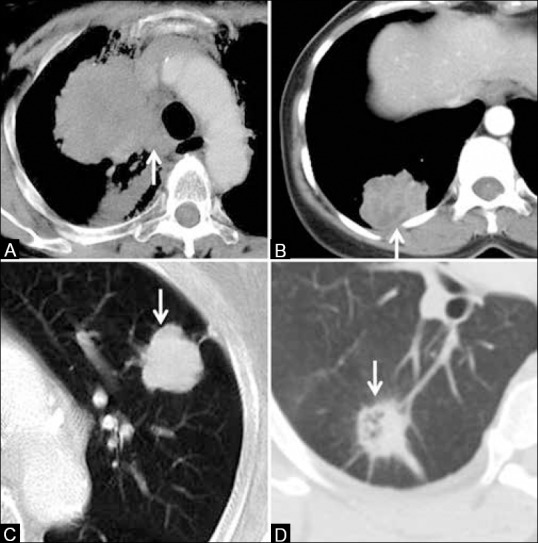 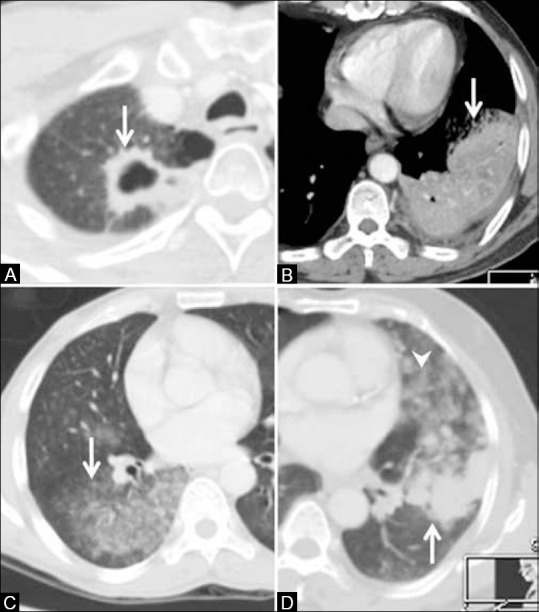 |
|}
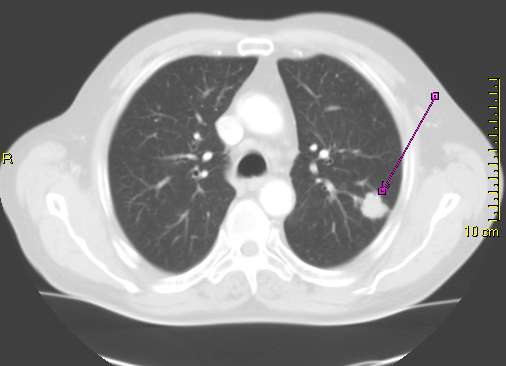 |
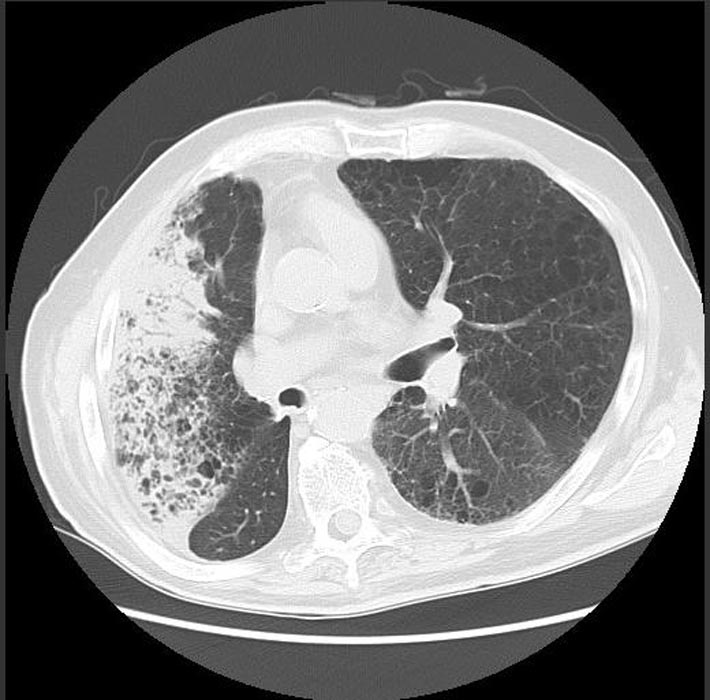 |
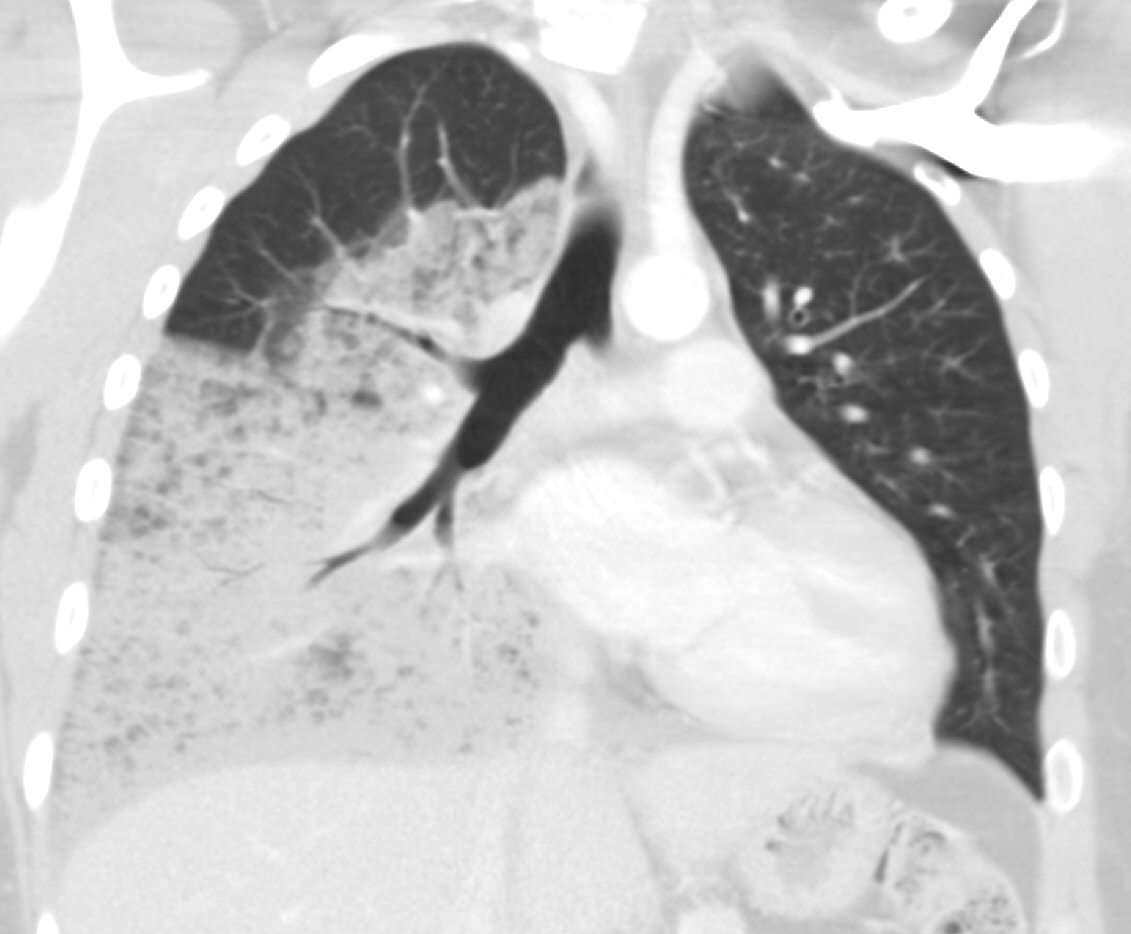 |
 |
References
- ↑ 1.0 1.1 1.2 Purandare, NilenduC; Rangarajan, Venkatesh (2015). "Imaging of lung cancer: Implications on staging and management". Indian Journal of Radiology and Imaging. 25 (2): 109. doi:10.4103/0971-3026.155831. ISSN 0971-3026.
- ↑ Gerard A. Silvestri, Lynn T. Tanoue, Mitchell L. Margolis, John Barker, Frank Detterbeck.11/30/11.The Noninvasive Staging of Non Small-cell Lung Cancer. Chestpubs. http://chestjournal.chestpubs.org/content/123/1_suppl/147S.full/